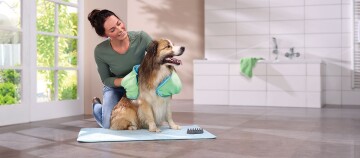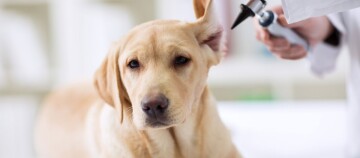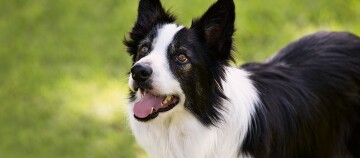Stop Paw Licking: Caring for Dog's Paws and What You Need to Bear in Mind
06.01.2024 - Reading time: 5 minutes
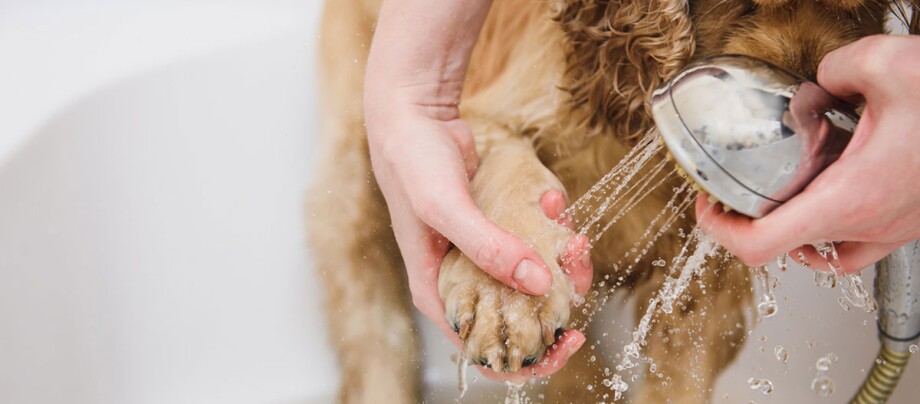
Maybe you have noticed your dog licking its paws or even nibbling on its claws? If so, then it is high time to take a closer look at the subject of "Paw care for dogs". What at first sounds like mere cosmetics can quickly become a health problem for your four-legged friend. By caring for your dog's paws properly, you can counteract any joint misalignment, make life difficult for mites and ticks and prevent inflammation of the pads. Find out here how to do this and what you need to bear in mind!
Paw health - why it is important to trim claws and groom paws
You should certainly be concerned about your dog’s paws and be taking care of them if it holds them at a slight angle when sitting or walking, or if it makes clicking noises like a tap dancer on a hard floor. This noise could indicate that your dog’s claws are too long. If it also often slips, it may be because the hair on its paws is too long.
But why is this the case today? In the days when dogs lived in the wild and hunted, nature took care of their paws. Running on hard surfaces, stones and rocks ensured regular abrasion of the claws even in puppyhood. Our „modern“ four-legged friends, on the other hand, do not move around often enough and often on soft ground, so that their claws continue to grow without experiencing natural abrasion. Some dogs have hairs sprouting between their paw pads, which hinder the dog’s walking if they grow too long. They therefore need to be regularly cleaned and trimmed.
This will help you recognise when paw care is needed:
- Claws that touch the ground and press upwards
- The dog licks its paws
- The dog nibbles its paws
- It slips frequently on slippery floors
- Reluctant to run or walk
- Paws are at a slight angle
- Pain when walking
- Lameness, limping
A dog pedicure involving cutting and filing the claws and trimming the hair in the spaces between the pads can help.
Dangers and diseases in dogs as a result of unkempt paws
Excessively long claws hinder the dog when walking and can cause it pain: When the pads are uncurled, they are pushed upwards into the claw bed and exert unpleasant to painful pressure on the dog’s pads.
Your dog will try to avoid this pain by positioning its paws as far to the side as possible, which inevitably leads to permanent and late damage – from muscle tension to muscle hardening, joint damage and misalignment of the musculoskeletal system.
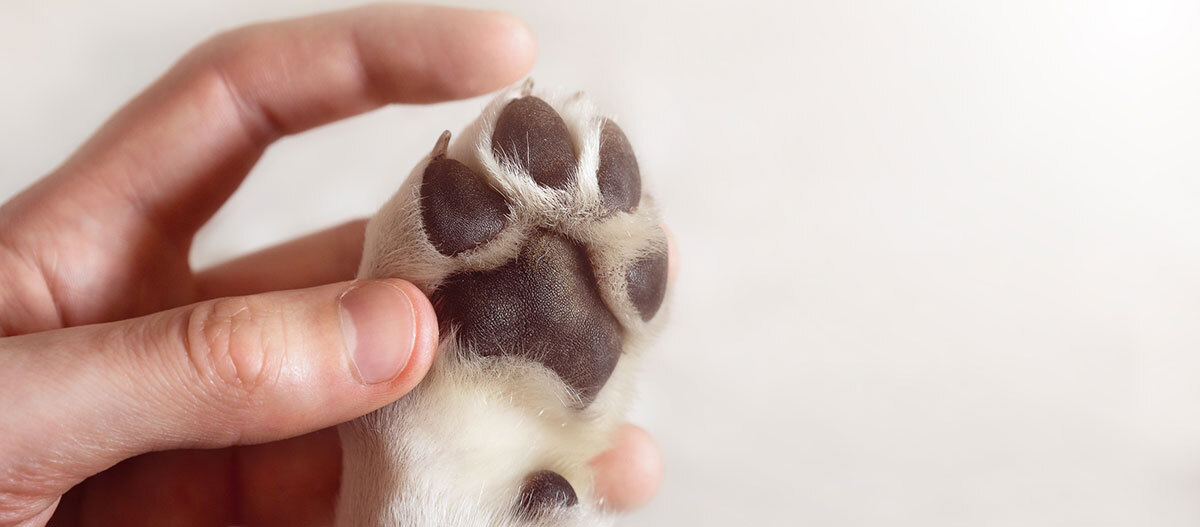
A dog that only walks on the tips of its claws cannot make proper use of its pads, which serve as a kind of ABS braking system and suspension in a normal state. In general, excessively long dog claws run the risk of tearing, breaking or even tearing off. The unused claws of the fifth toe, the so-called wolf claws, which are located on the hind legs slightly above the paw, can grow into the flesh and cause pain as well as inflammation. With long wolf claws, your dog can get caught on something in the bushes and may even tear them off.
Hair between the paw pads tends to mat and serves as a good hiding place for parasites such as ticks and mites. In winter, stinging road salt, injurious grit and permanent dirt can accumulate there, causing inflammations or infections.
Tips for proper paw care
For paw care, you will need a small standard kit with utensils such as:
- Special claw clippers, for small dogs a claw trimmer will suffice
- Fur scissors with blunt ends
- Claw file
- Torch, headlamp or other strong light source
- A small bathtub if necessary
- Special paw ointment
If your dog has hair hanging over its paws, trim it to the height of the claws. Hair in the spaces between the paw pads should also be cut away to prevent it from matting and causing the dog to slip. Only use special scissors with rounded ends for this.
If your dog’s paws have become particularly damaged, treat them to a paw bath. To do this, pour a sufficient amount of lukewarm water into a tub and shampoo its paws. Then rinse them thoroughly and dry them carefully with an absorbent towel. Then proceed to trim the claws and massage the paw pads with paw ointment.
Claw trimming requires a certain amount of practice in using the claw nippers and file in addition to a calm dog that will trustingly give you its paw. When cutting the claws for the first time, we recommend that you have a vet present to supervise and advise you.
Dogs‘ claws should be cut so that they do not touch the ground. It is also important not to damage the so-called vital tissue inside the dog’s claw, as it will bleed a lot and cause the dog a lot of pain. Read in the Maxi Zoo guide „Cutting the dog’s claws“ to find out how to make this often unpleasant claw procedure as comfortable as possible for your dog.
Paw care in winter: why is it important?
During the cold season, roads and paths may not only become as slippery as glass, but also really uncomfortable for your dog’s paws. Road salt or hard grit can tear your dog’s paw pads and cause uncomfortable burning or even bloody injuries that can potentially lead to inflammation. Grit, ice and snow between the toes can also cause your dog a lot of discomfort in winter, especially if they get caught in the long or matted hair between the pads.
For this reason, sensible winter precautions should be taken to protect the dog's sensitive paws:
- Trim the fur around the paw and between the pads.
- Keep the pads supple with special paw ointment.
- Get special dog shoes or weatherproof socks for particularly sensitive paws.
After the winter walk: paw check with care factor
The winter care programme begins once you return from a walk. First clean your dog’s paws with warm water and then dry them well. In the process, you should carefully examine the pads for cracks or injuries and check the condition of the claws. Finally, lubricate the paws with a special paw ointment. This will keep the pads supple, optimally protected and healthy for a long time. Now your dog can scamper off again! After a walk in the snow, your dog may nibble and lick his paws as a result of the tingling and increased blood circulation.
